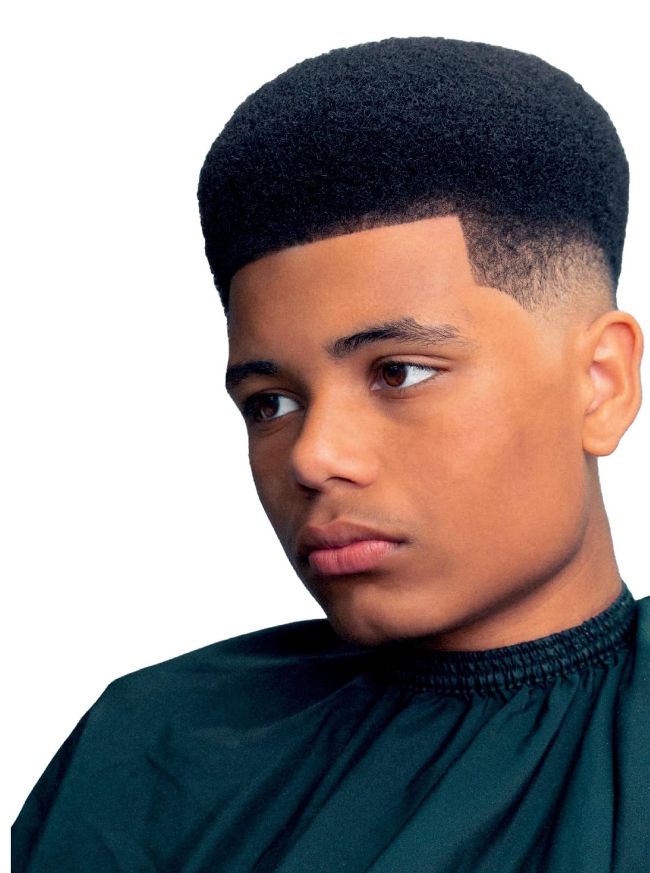FEATURE
LET’S TALK TEXTURE
WE SPOKE TO FIVE EXPERIENCED BARBERS ABOUT THE CHALLENGES FACED BY CLIENTS WITH AFRO TEXTURED HAIR, EXPLORING THE CONSEQUENCES OF AN INDUSTRY SKILLS GAP AND HOW WE CAN CHANGE OUR APPROACH TO HAIR EDUCATION
A new study by Ripe Hair & Beauty Insurance, which surveyed over two thousand UK residents on their experience with hairstylists and barbers in August 2023, revealed people with Afro textured hair pay more, travel further, and wait longer for salon appointments than other hair types. In recent years, the barbering industry has undergone a transformation, adapting to changing trends and customer demands, however one aspect that often remains overlooked is the need for improved education and skills when it comes to Afro textured hair.
Closing this gap is crucial for the evolution of the barbering profession. We spoke to leading Afro textured hair experts to discuss the steps that barbers, and the industry as a whole, can take.
LET’S TALK TERMINOLOGY
Anderson Boyce explains that different terminology can be used in different environments, such as a training academy versus on the shop floor; for the latter, he says he opts for the term Afro hair. Mark Maciver agrees, adding: “I don’t use descriptors like ‘coarse’ or ‘curly’ because those terms can be ambiguous. When you say ‘curly hair’ it can apply to both African and European hair types.”
The Andre Walker Hair Typing System, also referred to as the classification system, has been widely used since the 1990s, and is often referenced when describing hair types – but does it have a place in barbering? “In our educational environment, yes we use the classification system, but on the shopfloor not so much,” says Anderson.
“I think the classification system is a great way of understanding the difference in curl types and patterns with textured hair,” says Tariq Howes, but advises that barbers shouldn’t judge textured hair as a singular hair type as there can be multiple hair types in one head of hair. Dan O’Brien agrees, sharing: “It’s important to know what hair type you are working with as different hair types react differently.” Meanwhile, Brian Nosa tells us that for him the classification system is used more often in hairdressing than in barbering, “I think it would be great to educate more barbers in the hair typing system. All forms of education are great, but that’s not to say we can’t come up with new methods, too.”

TARIQ HOWES
" I’ve had clients coming to me not realising the possibilities of their hair, because other barbers haven’t been able to demonstrate sufficient knowledge.
While the hair typing system can have its benefits, there are still other elements to consider when working with Afro textured hair. “What matters to me is understanding my client—the shape of their head, the thickness of their hair—and figuring out what style suits them best,” says Mark who explains that even if two people have the same hair type, their haircuts will inevitably look different.
PROVIDING A POSITIVE EXPERIENCE
Having an understanding of Afro textured hair is crucial to a positive experience for clients. “A client that eventually found my salon had previously booked in with someone who claimed to be a specialist in textured hair – however the stylist lacked experience with their particular hair type,” Tariq tells us, this led to them having a disappointing experience because the cut didn’t complement their natural texture, “It’s not as simple as being able to do a few cuts on Afro hair, it’s about really understanding the client’s hair and needs.”

BRIAN NOSA
Dan explains that due to a lack of education, some of his clients don’t understand the possibilities of what can be achieved with their hair: “You can see a real boost in confidence when a client leaves after a good haircut,” he says.
Mark tells us that when striving to create a positive experience for clients, it’s also important to encourage feedback – good or bad: “We are a service industry, receiving complaints is inevitable. What truly matters is how these complaints are handled. In my shop, we encourage clients to voice their concerns openly.”
LOOKING AHEAD
“Client dissatisfaction stems from the inadequacy of education and a lack of provision when it comes to diverse hair types, and these client experiences, while disappointing, highlight the need for improvement,” says Tariq. Reflecting on the current provision of training for Afro textured hair, Anderson tells us: “The training and education available is pretty non-existent, and where it does exist, it’s sub-standard.” Brian agrees, with the changes to the National Occupational Standards (NOS) only coming into force in 2021 there is still a long way to go: “In my experience, there is not sufficient education in Afro hair. I’ve found more information from platforms like YouTube, as opposed to in-person courses.” Expanding on the particular skills he believes education providers should focus on, Brian says: “They need to teach more about different products, combs, guards and clippers, for Afro hair.”
Meanwhile, Mark tells us that despite not having requisite teaching qualifications he has been approached by barbers looking to improve their education: “People have asked me to teach them about cutting Afro hair -I think that highlights that there aren’t enough teachers who specialise in Afro hair.” Mark suggests increasing resources in big cities such as London, Sheffield, Birmingham and Manchester, where there is a higher number of Afro textured hair clients.
Ultimately, empowering your clients to embrace their natural hair and providing them with the knowledge and tools to care for it will not only contribute to a positive experience but will also promote diversity in grooming and barbering standards.
ANDERSON BOYCE
Master Barber and Lead Educator, Hairforce1 Training Academy
TARIQ HOWES
BaByliss PRO ambassador and owner of Avenue Male Grooming
DAN O’BRIEN
Barber and Educator
MARK MACIVER AKA SLIDERCUTS
Barber, Style & Groom
BRIAN NOSA
Barber, Rick Roberts Salon